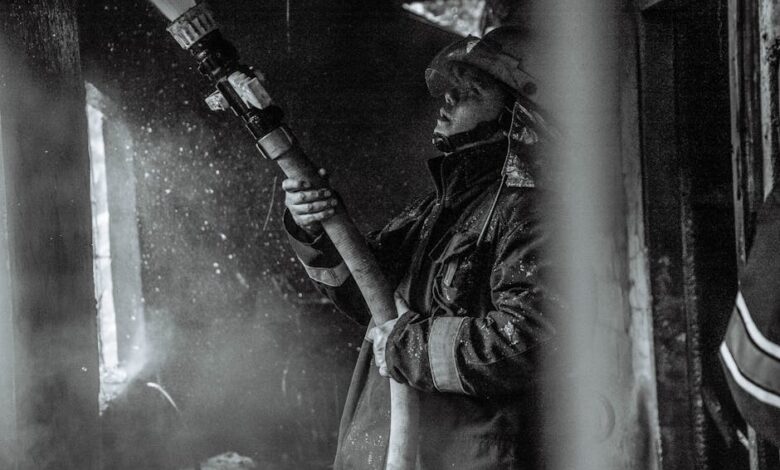The LA Fires Spewed Out Toxic Nanoparticles. He Made It His Mission to Trace Them.

The LA Fires Spewed Out Toxic Nanoparticles. He Made It His Mission to Trace Them.
Estimated Reading Time: 5 minutes
- LA wildfires are producing highly toxic nanoparticles from burning urban materials (plastics, electronics), making the smoke far more dangerous than traditional forest fires.
- Scientist Nicholas Spada uses nuclear x-ray technology to identify these deadly nanoparticles, uncovering elevated levels of heavy metals (lead, arsenic, chromium) and synthetic organic compounds in wildfire smoke.
- These ultra-fine particles, invisible to the naked eye, penetrate deep into the lungs and bloodstream, exacerbating respiratory conditions, triggering cardiovascular events, and contributing to long-term health issues.
- Protection involves vigilant monitoring of local air quality (AQI, PM2.5 levels), optimizing indoor air with sealed windows, MERV-13 filters, and HEPA purifiers, and using N95/P100 respirator masks outdoors.
- Spada’s research redefines urban-adjacent wildfires as complex industrial burn events with severe, under-recognized public health consequences, demanding urgent policy changes and public awareness.
- The Invisible Enemy: Why Wildfire Smoke is More Dangerous Than You Think
- Unveiling the “Nightmare”: Nicholas Spada’s Groundbreaking Research
- Protecting Yourself and Your Community: Actionable Steps Against Toxic Smoke
- Conclusion
- Frequently Asked Questions (FAQ)
California’s wildfires are a devastating annual reality, leaving behind a trail of destruction that is both visible and, increasingly, invisible. Beyond the charred landscapes and displaced communities, these blazes unleash a silent, insidious threat: microscopic particles that infiltrate our bodies and ecosystems. While we’ve long understood the general dangers of smoke, groundbreaking research is now revealing a far more sinister truth about its composition, particularly in urban-adjacent areas like Los Angeles.
The smoke from these fires isn’t just wood ash; it’s a complex cocktail of burning natural vegetation, plastics, electronics, building materials, and vehicle components. This creates a particulate matter problem of unprecedented toxicity. One dedicated scientist has made it his life’s work to uncover the true nature of this invisible enemy, and what he’s found is nothing short of alarming.
The Invisible Enemy: Why Wildfire Smoke is More Dangerous Than You Think
When wildfires rage, the most immediate danger we often consider is the flames themselves. However, the subsequent smoke plumes pose a long-term, widespread health crisis. While large ash particles are easily filtered by our bodies, the real danger lies in what scientists call PM2.5 – particulate matter smaller than 2.5 micrometers. These tiny particles, invisible to the naked eye, can bypass our body’s natural defenses, penetrating deep into the lungs and even entering the bloodstream.
What makes wildfire PM2.5 particularly menacing in areas like Los Angeles is not just its size, but its chemical makeup. As fires consume homes, vehicles, and industrial infrastructure in the urban-wildland interface, the smoke becomes a deadly brew. It carries heavy metals like lead and cadmium, carcinogenic organic compounds, and even persistent organic pollutants that were never meant to be aerosolized. This toxic combination can exacerbate respiratory conditions, trigger cardiovascular events, and contribute to long-term neurological damage and cancers.
The sheer volume and widespread dispersion of these ultra-fine particles mean that even those far from the fire lines are exposed. This widespread exposure poses a significant public health challenge, demanding more precise understanding and urgent preventative measures.
Unveiling the “Nightmare”: Nicholas Spada’s Groundbreaking Research
Enter Nicholas Spada, a scientist with a unique and critical mission. Frustrated by the lack of detailed understanding of wildfire smoke’s true toxicity, he sought out a revolutionary method to analyze its minute components. His work is shedding light on the precise chemical signature of smoke from fires that burn through urbanized areas, revealing a “nightmare” scenario.
Nicholas Spada is one of the only scientists in the world using a nuclear x-ray process to study deadly nanoparticles in wildfire smoke. What he’s uncovered in California is a nightmare. This cutting-edge technique, known as Particle-Induced X-ray Emission (PIXE) or similar synchrotron radiation methods, allows Spada to analyze individual smoke particles down to their elemental composition at an incredibly small scale. It’s like having an ultra-powerful microscope that can identify every tiny piece of a puzzle.
What Spada’s nuclear x-ray process has consistently revealed in samples from LA fires is a frightening array of elements not typically found in natural forest fires. He’s detected elevated levels of lead, arsenic, chromium, copper, and zinc – metals commonly found in paints, electronics, batteries, and other household items. Alongside these are complex synthetic organic compounds, products of incomplete combustion of plastics and petrochemicals. This cocktail of urban pollutants makes the smoke exponentially more dangerous than previously thought.
The “nightmare” Spada refers to isn’t just the presence of these toxins, but their prevalence and the insidious way they disperse. These nanoparticles remain airborne for extended periods, travel vast distances, and when inhaled, deliver their toxic payload directly into our bodies. His findings underscore a stark reality: fires burning through developed areas are not just natural disasters; they are complex industrial burn events with severe, under-recognized public health consequences.
Protecting Yourself and Your Community: Actionable Steps Against Toxic Smoke
Understanding the threat is the first step; taking action is the next. While we can’t stop wildfires, we can significantly reduce our exposure to their toxic fallout. Here are three actionable steps you can take to protect yourself and your loved ones from invisible nanoparticle threats:
- Monitor Local Air Quality Reports Diligently: Make it a habit to check air quality indices (AQI) from reliable sources like AirNow.gov or PurpleAir during fire season. Pay close attention to PM2.5 levels. When the AQI for PM2.5 is unhealthy (red, purple, or maroon), limit outdoor activities. Remember, even if smoke isn’t visible, tiny particles can still be present and harmful.
- Optimize Your Indoor Air Environment: Your home can be a sanctuary from smoke, but only if properly prepared.
- Ensure windows and doors are sealed tightly.
- If you have an HVAC system, upgrade your filter to a MERV-13 or higher, and ensure it’s functioning optimally.
- Invest in a portable air purifier with a HEPA filter for the rooms you spend most time in. These can effectively capture ultra-fine particles.
- Avoid activities that create indoor air pollution, such as burning candles, using gas stoves, or vacuuming without a HEPA filter, especially during smoke events.
- Employ Personal Protective Equipment (PPE) When Necessary: If you must go outdoors during periods of heavy smoke or poor air quality, wear an N95 or P100 respirator mask. Cloth masks or surgical masks do not provide adequate protection against PM2.5 nanoparticles. Ensure the mask fits snugly over your nose and mouth to create a proper seal.
Real-World Impact: A Silent Health Burden
Consider the aftermath of the Woolsey Fire that swept through parts of Los Angeles and Ventura counties. While immediate concerns focused on rebuilding, many residents reported persistent respiratory issues, headaches, and a general feeling of malaise long after the smoke cleared. For years, these symptoms were often attributed to generic “smoke exposure.” Spada’s research now offers a chilling explanation: these communities were likely subjected to an ongoing, invisible assault from a unique blend of urban-fire nanoparticles, turning their returning homes into zones of continuous low-level toxic exposure, far more dangerous than simple wood ash.
Conclusion
The revelation that LA fires are spewing out highly toxic nanoparticles, far beyond what we traditionally understood about wildfire smoke, is a stark wake-up call. Nicholas Spada’s pioneering work, utilizing advanced nuclear x-ray processes, has not only exposed a hidden health threat but also redefined the narrative around wildfires in urban-wildland interfaces. These are no longer just natural events; they are complex chemical releases with profound implications for public health and environmental safety.
The “nightmare” Spada uncovered demands our immediate attention and proactive measures. By staying informed, improving our indoor environments, and utilizing appropriate personal protection, we can mitigate the risks. Ultimately, this research underscores the urgent need for more comprehensive policies, urban planning strategies, and public awareness campaigns to address the growing menace of toxic nanoparticle pollution from wildfires.
Learn More & Share This Article
Frequently Asked Questions (FAQ)
What makes LA wildfire smoke more dangerous than typical forest fire smoke?
LA wildfire smoke is more dangerous because it contains a complex cocktail of burning urban materials like plastics, electronics, building materials, and vehicle components, in addition to natural vegetation. This creates highly toxic nanoparticles, including heavy metals and carcinogenic organic compounds, not typically found in natural forest fires.
Who is Nicholas Spada and what is his significant discovery?
Nicholas Spada is a scientist who uses a nuclear x-ray process (like PIXE) to study deadly nanoparticles in wildfire smoke. His significant discovery is that smoke from LA fires contains a “nightmare” array of elements like lead, arsenic, chromium, copper, and zinc, along with synthetic organic compounds, indicating these fires are complex industrial burn events with severe public health consequences.
What are PM2.5 particles and why are they so harmful?
PM2.5 refers to particulate matter smaller than 2.5 micrometers, which are invisible to the naked eye. They are so harmful because their tiny size allows them to bypass the body’s natural defenses, penetrating deep into the lungs and even entering the bloodstream. In wildfire smoke, they carry toxic payloads that can cause immediate and long-term health issues.
What are the key steps to protect myself from toxic wildfire smoke?
Key steps include diligently monitoring local air quality reports (e.g., AirNow.gov, PurpleAir) for PM2.5 levels, optimizing your indoor air environment by sealing windows, using MERV-13 HVAC filters, and investing in HEPA air purifiers, and employing N95 or P100 respirator masks if you must go outdoors during poor air quality.
How has Nicholas Spada’s research changed our understanding of wildfires?
Spada’s research has profoundly changed our understanding by demonstrating that fires burning through developed areas are not merely natural disasters but complex industrial burn events. His work highlights the presence of unique, highly toxic nanoparticle compositions in urban wildfire smoke, revealing a far greater and insidious threat to public health than previously acknowledged.




